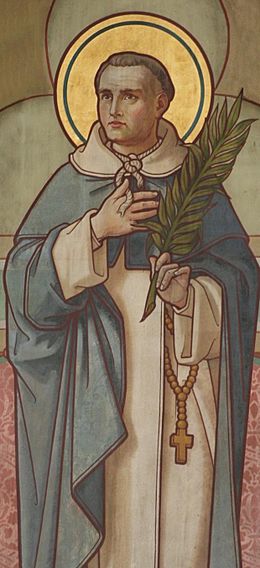John of Cologne facts for kids
Quick facts for kids SaintJohn of Cologne O.P. |
|
|---|---|
 |
|
| Religious, priest and martyr | |
| Born | Electorate of Cologne |
| Died | 9 July 1572 Brielle, Spanish Netherlands |
| Beatified | 14 November 1675 by Pope Clement X |
| Canonized | 29 June 1865 by Pope Pius IX |
| Major shrine | Bedevaarts Church, Brielle, South Holland, Netherlands |
| Feast | 9 July |
John of Cologne (also known as Joannes van Hoornaar) was a Dominican friar and priest. He was born in the Electorate of Cologne, which is now part of Germany. Later, he became a parish priest in the village of Hoornaar in what was then the Spanish Netherlands. John was killed in 1572 because of his Catholic faith. The Catholic Church honors him as a martyr and a saint.
Contents
The Dutch Fight for Freedom
Between 1550 and 1560, the Dutch provinces were trying to become independent. They wanted to break away from the Spanish Empire and its ruler, King Philip II.
The Sea Beggars
The Geuzen (pronounced "HOO-zen") were a group of people who fought against Spanish rule. They were also known as the Sea Beggars. These adventurers and pirates used ports in places like Emden, La Rochelle, and Dover as their bases. From these ports, the Sea Beggars attacked Spanish ships. They also raided fishing villages and towns along the Dutch coast.
John's Life and Faith
Not much is known about John's early life. We do know that he studied at the University of Cologne. At that time, this university was one of the best schools in Europe. After his studies, John joined the Dominican Order in Cologne.
Serving in Hoornaar
Once he finished his training, John was sent to serve as a priest. He worked in the Dutch village of Hoornaar for the next twenty years.
Religious Changes in Europe
By 1572, new Christian beliefs had spread across Europe. These included Lutheranism and Calvinism. In the Netherlands, Calvinism became very strong.
On April 1, 1572, Calvinists and a group called the Watergeuzen (Sea Beggars) captured the town of Brielle. Later, they also took Flushing. In June of that year, Dordrecht and Gorkum also fell to them.
Capturing Catholic Priests
When the Sea Beggars took these towns, they arrested all the Catholic priests. They held them captive. The Sea Beggars tried to force the priests to give up their Catholic beliefs. They especially wanted them to deny the Catholic teachings on the Eucharist and the papal primacy (the Pope's authority).
John's Courageous Act
John heard about what had happened to his fellow priests. He bravely disguised himself and tried to help them. He wanted to bring them comfort and the sacraments. John secretly ministered to the captured priests. However, he was eventually discovered and taken prisoner himself.
These nineteen priests were held in Gorkum from June 26 to July 6. Meanwhile, William the Silent, the Prince of Orange, sent a letter. He told those in charge to leave priests and religious people alone. But Lumey, the commander of the Watergeuzen, ignored this order. He commanded that the priests be killed on the night of July 9.
The Martyrs of Gorkum
The Roman Catholic Church calls these priests the Martyrs of Gorkum. They were officially declared saints by Pope Pius IX in 1867. Their remains are honored at a special shrine built in their memory in Brielle.
See also
 In Spanish: Juan de Colonia (santo) para niños
In Spanish: Juan de Colonia (santo) para niños

